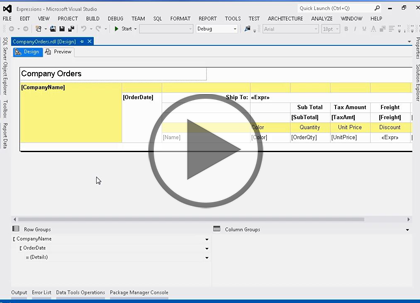Watch trailer
Course at a glance
Included in these subscriptions:
- Dev & IT Pro Video
- Dev & IT Pro Power Pack
| Release date | 9/10/2015 | |
| Level | Intermediate | |
| Runtime | 1h 18m | |
| Closed captioning | Included | |
| Transcript | Included | |
| eBooks / courseware | Included | |
| Hands-on labs | Included | |
| Sample code | Included | |
| Exams | Included |
Course description
In this course you’ll get a high-level view of the parts and pieces of Reporting Services so that you know what you’re working with. I’ll start by looking at the two modes you can install and operate a report server in. Then I’ll show you some of the extensive configuration options you can use to fine tune reporting features. Reporting Services has a fairly complex architecture, and I’ll walk you through a high-level view of it. There are a lot of parts and you need to have a good feel for how they all work. Then I’ll take a look at the tools available for building reports, and will walk through creating a simple report using Report Designer.Next you’ll get a solid introduction to Report Builder, and learn how to install either the standalone version or the ClickOnce version accessible from Report Manager. I’ll walk you through a tour of the Report Builder user interface. Then I’ll show you how to build a simple report, point out more of Report Builder’s features and learn about preview performance. Finally, you’ll learn about shared datasets as a way to make data access easier for end users.
Prerequisites
This course assumes that you have a basic familiarity with the concept of relational databases and a basic understanding of what SQL Server is and the high-level tools in it, as well as how to create and manage objects using Management Studio. You should also have a basic understanding of how SQL Server implements security, including its authentication and authorization schemes, and how to assign permissions on securable objects to principals. You should know the fundamentals of Transact-SQL to write queries to retrieve data and join data from multiple tables, and how to execute scripts using the query editor in Management Studio.
It will be very helpful, but not absolutely necessary, to have experience with .NET development using Visual Studio 2010 or 2012 for the portions of the course that deal with SQL Server Data Tools. At the very least, we’ll assume that you are well familiar with the Visual Studio user interface.
The focus of this course is the Reporting Services Native Mode installation to learn the fundamentals of creating and managing reports. Almost all of what you’ll learn will be applicable to a SharePoint integrated mode installation as well, but there are additional tools and considerations for SharePoint that aren’t covered thoroughly here.
This course is written using Windows 7 and 8.1, we assume you know how to start programs, etc. in whatever version of Windows you’re using. The Reporting Services features should be pretty much the same in SQL Server 2014, although some windows will probably look different; but the feature set is the same.
Learning Paths
This course will help you prepare for the following certifications and exams:
MCSE: Business Intelligence
70-467: Designing Business Intelligence Solutions with Microsoft SQL Server
70-466: Implementing Data Models and Reports with Microsoft SQL Server
This course is part of the following LearnNowOnline SuccessPaths™:
SQL Server Reporting Services
Meet the expert
Don Kiely is a featured instructor on many of our SQL Server and Visual Studio courses. He is a nationally recognized author, instructor, and consultant specializing in Microsoft technologies. Don has many years of teaching experience, is the author or co-author of several programming books, and has spoken at many industry conferences and user groups. In addition, Don is a consultant for a variety of companies that develop distributed applications for public and private organizations.
Course outline
Expressions and Functions
Writing and Using Expressions (15:29)
- Introduction (00:52)
- Writing and Using Expressions (01:43)
- Using the Expression Editor (00:13)
- Demo: Expressions (03:10)
- Demo: Expression Editor (04:09)
- Demo: Building an Expression (04:51)
- Summary (00:28)
Report Operators and Functions (19:36)
- Introduction (00:29)
- Expression Operators (00:18)
- Demo: Operators (03:59)
- Built-in Functions (00:48)
- Demo: Immediate If (03:44)
- Demo: Switch Function (05:11)
- Demo: Choose Function (00:28)
- Using Other Built-In Functions (02:04)
- Null Handling (02:06)
- Summary (00:24)
The Global Collections (16:28)
- Introduction (00:34)
- The Global Collections (00:39)
- The Fields Collection (01:02)
- Globals Collection (02:40)
- User Collection (01:13)
- ReportItemsCollection (01:08)
- Variables Collection (01:04)
- Demo: Global Fields (04:20)
- Demo: Times (03:20)
- Summary (00:24)
Creating Custom Functions (07:17)
- Introduction (00:42)
- Creating Custom Functions (01:06)
- Demo: Custom Functions (04:57)
- Summary (00:31)
Sharing Custom Code (19:34)
- Introduction (00:35)
- Sharing Custom Code (02:07)
- Creating a Custom Assembly (03:20)
- Demo: Custom Assemblies (04:29)
- Demo: Report (03:33)
- Demo: References (04:51)
- Summary (00:35)



